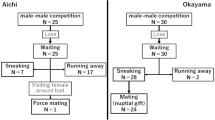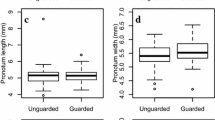Abstract
InNannophya pygmaea, ovipositing females were frequently disturbed by conspecific males. Disturbed females often copulated with one of these males or flew away from the pool. Females which flew away from the pool due to male disturbance often returned later the same day and mated with different males. A territorial male would guard his ovipositing mate by hovering above her, presumably trying to prevent her from moving out of his territory. A non-territorial male would also guard his mate in a similar way, both at a vacant water area which was not occupied by any territorial males, or within the territory of a resident male. In addition, both territorial and non-territorial males chased intruding males in an attempt to prevent their mates from being stolen. Territorial males defended their mates better than non-territorial males. Both males and females often mated more than once in the course of a single day. Some territorial males copulated with a new female while another mate oviposited in their territories. This observation supported the “multiple mating hypothesis” proposed by Alcock (1979) and Uéda (1979) but other evidence suggested that this is an inadequate explanation for the non-contact guarding ofN. pygmaea.
Similar content being viewed by others
References
Alcock, J. 1979 Multiple matings inCalopteryx maculata (Odonata: Calopterygidae) and the advantage of non-contact guarding by males.J. Nat. Hist. 13: 439–446.
Alcock, J. 1982 Postcopulatory mate guarding by males of the damselflyHetaerina vulnerata Selys (Odonata: Calopterygidae).Anim. Behav. 30: 99–107.
Corbet, P. S. 1980 Biology of Odonata.Ann. Rev. Ent. 25: 189–217.
Davies, N. B. 1978 Territorial defence in the speckled wood butterfly (Pararge aegeria): the resident always wins.Anim. Behav. 26: 138–147.
Emlen, S. T. & L. W. Oring 1977 Ecology, sexual selection, and the evolution of mating systems.Science 197: 215–223.
Fincke, O. M. 1984 Sperm competition in the damselflyEnallagma hageni Walsh (Odonata: Coenagrionidae): benefits of multiple mating to males and females.Behav. Ecol. Sociobiol.14: 235–240.
Fujita, K., K. Hirano, M. Kawanishi, N. Osaki, E. Yano, & M. Yasuda 1978 Ecological studies on a dragonfly,Nannophya pygmaea Rambur (Odonata: Libellulidae). I. Seasonal changes of adult pupulation and its distribution in a habitat.Res. Popul. Ecol. 19: 209–221.
McVey, M. E. & B. J. Smittle 1984 Sperm precedence in the dragonflyErythemis simplicicollis.J. Insect Physiol. 30: 619–628.
Miller, P. L. 1981 Functional morphology of the penis ofCelithemis eponiana Druly (Anisoptera: Libellulidae).Odonatologica 10: 293–300.
Nakamuta, K., Y. Tsubaki, M. Yasuda, Y. Hibino, & T. Ono 1983 Male reproductive behavior of the tiny dragonfly,Nannophya pygmaea Rambur.Kontyû, Tokyo 51: 605–613.
Parker, G. 1970 Sperm competition and its evolutionary consequences in the insects.Biol. Rev. 45: 525–567.
Parker, G. 1974 Courtship persistence and female-guarding as male time investment strategies.Behaviour 48: 157–184.
Sakagami, S. F., H. Ubukata, M. Iga, & M. J. Toda 1974 Observations on the behaviour of some Odonata in the Bonin Islands, with considerations on the evolution of reproductive behavior in Libellulidae.J. Fac. Sci. Hokkaido Univ. Ser. 6, Zool. 19: 722–757.
Sherman K. J. 1983 The adaptive significance of postcopulatory mate guarding in a dragonfly,Pachydiplax longipennis.Anim. Behav. 31: 1107–1115.
Siva-Jothy, M. T. 1985 Sperm competition in the family Libellulidae (Odonata) with special reference toCrocothemis erythraea (Brulle) andOrthetrum cancellatum (L).Adv. in Odonatol. (in press).
Tsubaki, Y. & T. Ono 1986 Competition for territorial sites and alternative mating tactics in the dragonfly,Nannophya pygmaea Rambur (Odonata: Libellulidae).Behaviour (in press).
Uéda, T. 1979 Plasticity of the reproductive behaviour in a dragonfly,Sympetrum parvulum Barteneff, with reference to the social relationship of males and the density of territories.Res. Popul. Ecol. 21: 135–152.
Waage, J. K. 1979 Dual function of the damselfly penis: sperm removal and transfer.Science 203: 916–918.
Waage, J. K. 1982 Sperm displacement by maleLestes vigilax Hagen (Odonata: Zygoptera).Odonatologica 11: 201–209.
Waage, J. K. 1984 Sperm competition and the evolution of odonate mating systems. In: R. L. Smith (ed.)Sperm competition and the evolution of animal mating systems. pp. 251–290. Academic Press, New York.
Yamamoto, Y. 1968 Life history of the adult dragonfly ofNannophya pygmaea.Tombo, Tokyo 11: 18–25. (In Japanese).
Author information
Authors and Affiliations
About this article
Cite this article
Tsubaki, Y., Ono, T. The adaptive significance of non-contact mate guarding by males of the dragonfly,Nannophya pygmaea Rambur (Odonata: Libellulidae). J. Ethol. 3, 135–141 (1985). https://doi.org/10.1007/BF02350304
Received:
Accepted:
Issue Date:
DOI: https://doi.org/10.1007/BF02350304




